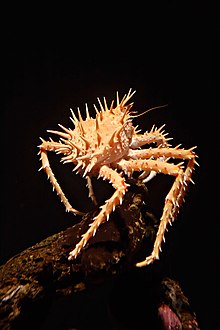
Back سلطعون ملك Arabic سلطعون الملك ARZ Litòdids Catalan Lithodidae CEB Troldkrabbe Danish Stein- und Königskrabben German Lithodidae Spanish شاهخرچنگ Persian Kiviravut Finnish Lithodidae French
| King crabs Temporal range:
| |
|---|---|

| |
| Paralithodes californiensis | |
| Scientific classification | |
| Domain: | Eukaryota |
| Kingdom: | Animalia |
| Phylum: | Arthropoda |
| Class: | Malacostraca |
| Order: | Decapoda |
| Suborder: | Pleocyemata |
| (unranked): | Reptantia |
| Infraorder: | Anomura |
| Superfamily: | Paguroidea Samouelle, 1819 |
| Family: | Lithodidae Samouelle, 1819 |
| Genera[1] | |
|
Hapalogastrinae Brandt, 1850
Lithodinae Samouelle, 1819
| |

King crabs are decapod crustaceans in the family Lithodidae that are chiefly found in deep waters and are adapted to cold environments.[2][3] They are composed of two subfamilies: Lithodinae, which tend to inhabit deep waters, are globally distributed, and comprise the majority of the family's species diversity;[3][4] and Hapalogastrinae, which are endemic to the North Pacific and inhabit exclusively shallow waters.[3] King crabs are not true crabs and are generally thought to be derived from hermit crab ancestors within the Paguridae, which may explain the asymmetry still found in the adult forms.[4] This ancestry is supported by several anatomical peculiarities which are present only in king crabs and hermit crabs.[5] Although some doubt still exists about this hypothesis, king crabs are the most widely quoted example of carcinisation among the Decapoda.[5] Several species of king crabs, especially in Alaskan and southern South American waters, are targeted by commercial fisheries and have been subject to overfishing.[2][6][7]
Cite error: There are <ref group=lower-alpha> tags or {{efn}} templates on this page, but the references will not show without a {{reflist|group=lower-alpha}} template or {{notelist}} template (see the help page).
- ^ De Grave, Sammy; Pentcheff, N. Dean; Ahyong, Shane T.; et al. (2009). "A classification of living and fossil genera of decapod crustaceans" (PDF). The Raffles Bulletin of Zoology. Suppl. 21: 1–109. Archived from the original (PDF) on 2011-06-06.
- ^ a b Poore, Gary C. B.; Ahyong, Shane T. (2023). Marine Decapod Crustacea: A Guide to Families and Genera of the World. CRC Press. ISBN 978-1-4863-1178-1.
- ^ a b c Hall, Sally; Thatje, Sven (October 2009). "Global bottlenecks in the distribution of marine Crustacea: temperature constraints in the family Lithodidae" (PDF). Journal of Biogeography. 36 (11): 2125–2135. Bibcode:2009JBiog..36.2125H. doi:10.1111/j.1365-2699.2009.02153.x. Archived (PDF) from the original on 29 May 2023.
- ^ a b Noever, Christoph; Glenner, Henrik (2017-07-05). "The origin of king crabs: hermit crab ancestry under the magnifying glass" (PDF). Zoological Journal of the Linnean Society. 182 (2): 300–318. doi:10.1093/zoolinnean/zlx033. Archived (PDF) from the original on 2019-07-16 – via the University of Copenhagen.
- ^ a b Keiler, Jonas; Richter, Stefan; Wirkner, Christian S. (2013-03-19). "Evolutionary morphology of the hemolymph vascular system in hermit and king crabs (Crustacea: Decapoda: Anomala)". Journal of Morphology. 274 (7): 759–778. doi:10.1002/jmor.20133. PMID 23508935. S2CID 24458262.
- ^ Dvoretsky, Alexander G.; Dvoretsky, Vladimir G. (November 2017). "Red king crab (Paralithodes camtschaticus) fisheries in Russian waters: historical review and present status". Reviews in Fish Biology and Fisheries. 28 (2): 331–353. doi:10.1007/s11160-017-9510-1. ISSN 0960-3166.
- ^ Cite error: The named reference
Klaus et al. 2004was invoked but never defined (see the help page).